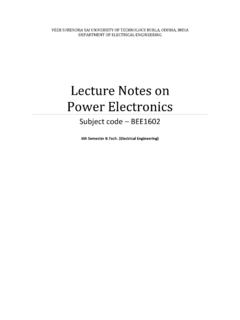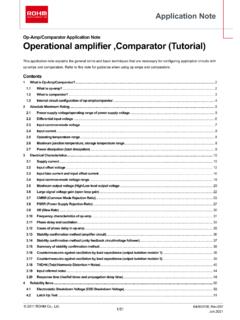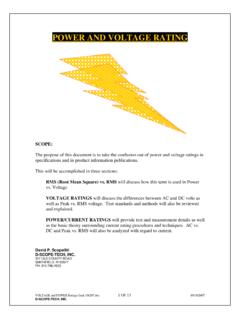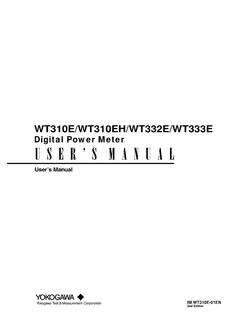Transcription of POWERFACTOR CORRECTION (pfc)
1 power FACTORCORRECTION22 IEE Wiring Matters |Spring 2006 | FACTOR is the ratio between the useful (true) power (kW) to the total (apparent) power (kVA)consumed by an item of electrical equipment or acomplete electrical installation. It is a measure of howefficiently electrical power is converted into usefulwork output. The ideal power factor is unity, or less than one means that extra power isrequired to achieve the actual task at current flow causes losses both in the supplyand distribution system. A load with a power factor results in the most efficient loading of the load with a power factor of, say, , results in muchhigher losses in the supply system and a higher billfor the consumer.
2 A comparatively small improvementin power factor can bring about a significantreduction in losses since losses are proportional to thesquare of the the power factor is less than one the missing power is known as reactive power whichunfortunately is necessary to provide a magnetisingfield required by motors and other inductive loads toperform their desired functions. Reactive power canalso be interpreted as wattless, magnetising or wastedpower and it represents an extra burden on theelectricity supply system and on the consumer s poor power factor is usually the result of asignificant phase difference between the voltage andcurrent at the load terminals, or it can be due to ahigh harmonic content or a distorted currentwaveform.
3 A poor power factor is generally the resultof an inductive load such as an induction motor, apower transformer, a ballast in a luminaire, a weldingset or an induction furnace. A distorted currentwaveform can be the result of a rectifier, an inverter, avariable speed drive, a switched mode power supply,discharge lighting or other electronic poor power factor due to inductive loads can beimproved by the addition of power factor correctionequipment, but a poor power factor due to a distortedcurrent waveform requires a change in equipmentdesign or the addition of harmonic filters.
4 Someinverters are quoted as having a power factor ofbetter than when, in reality, the true power factoris between and The figure of is based onthe cosine of the angle between the voltage andcurrent but does not take into account that thecurrent waveform is discontinuous and thereforecontributes to increased inductive load requires a magnetic field tooperate and in creating such a magnetic field causesthe current to be out of phase with the voltage (thecurrent lags the voltage). power factor CORRECTION isthe process of compensating for the lagging currentby creating a leading current by connectingcapacitors to the supply.
5 A sufficient capacitance isconnected so that the power factor is adjusted to be asclose to unity as factor explainedConsider a single-phase induction motor. If the motorpresented a purely resistive load to the supply, thecurrent flowing would be in-phase with the is not the case. The motor has a magnet and themagnetizing current is not in phase with the magnetizing current is the current thatestablishes the flux in the iron and, being out ofphase, causes the shaft of the motor to rotate. Themagnetizing current is independent of the load on themotor and will typically be between 20% and 60% ofthe rated full load current of the motor.
6 Themagnetizing current does not contribute to the workoutput of the a motor with a current draw of 10 Ampsand a power factor of The useful current is useful power from the motor is 230 = the total power that has to be supplied is 230 10 =By John WarePOWER FACTOR CORRECTION (pfc) power FACTORCORRECTIONIEE Wiring Matters |Spring 2006 | kVA. Without power factor CORRECTION , to achievethe required output of kW ( A) a power of (10 A) has to be supplied. A current of 10 A isflowing but only A of that current is producinguseful power factor can be expressed in two ways: power factor (pf) = Useful power (kW) divided by thetotal power (kVA), orPower factor (pf) = The cosine of the angle betweenuseful power and total power = cos.
7 power factor correctionPower factor CORRECTION is the term given to atechnology that has been used since the turn of the20th century to restore the power factor to as close tounity as is economically viable. This is normallyachieved by the addition of capacitors to the electricalnetwork which compensate for the reactive powerdemand of the inductive load and thus reduce theburden on the supply. There should be no effect on theoperation of the reduce losses in the distribution system, and toreduce the electricity bill, power factor CORRECTION ,usually in the form of capacitors, is added to neutralizeas much of the magnetizing current as contained in most power factor correctionequipment draw current that leads the voltage, thusproducing a leading power factor.
8 If capacitors areconnected to a circuit that operates at a nominallylagging power factor, the extent that the circuit lags isreduced proportionately. Typically the corrected POWERFACTOR will be to Some power distributors offerincentives for operating with a power factor of betterthan , for example, and some penalize consumerswith a poor power factor. There are many ways thatthis is metered but the net result is that in order toreduce wasted energy in the distribution system, theconsumer is encouraged to apply power factorcorrection. Most Network Operating companies nowpenalize for power factors below or improve power factor ?
9 The benefits that can be achieved by applying thecorrect power factor CORRECTION are: Environmental benefit. Reduction of powerconsumption due to improved energy power consumption means less greenhousegas emissions and fossil fuel depletion by powerstations. Reduction of electricity bills Extra kVA available from the existing supply Reduction of I2R losses in transformers and distributionequipment Reduction of voltage drop in long cables. Extended equipment life Reduced electrical burden on cablesand electrical components. iV i `i ViV i >}i* V ` V V i >}iV i ` > L iv V i >} i VV i iv i > i 6 >} i V i 6 Phaser diagram of KW, KVA, and KVArPhaser diagram of currentsPower supply to induction motorPhaser diagram of voltage and currentPOWER FACTORCORRECTIONIEE Wiring Matters |Spring 2006 | to improve power factorPower factor CORRECTION is achieved by the addition of capacitors in parallel with the connected motor or lighting circuits and can be applied at the equipment.
10 Distribution board or at the origin of the power factor CORRECTION can be applied at each individualmotor by connecting the CORRECTION capacitors to the motorstarter. A disadvantage can occur when the load on the motorchanges and can result in under or over CORRECTION . Static POWERFACTOR CORRECTION must not be applied at the output of a variablespeed drive, solid state soft starter or inverter as the capacitorscan cause serious damage to the electronic components. Over- CORRECTION should not occur if the power factor CORRECTION iscorrectly sized. Typically the power factor CORRECTION for anindividual motor is based on the non load (magnetizing) powersince the reactive load of a motor is comparatively constantcompared to actual kW load over compensation should be should be taken when applying power factor correctionstar/delta type control so that the capacitors are not subjected torapid on-off-on conditions.















